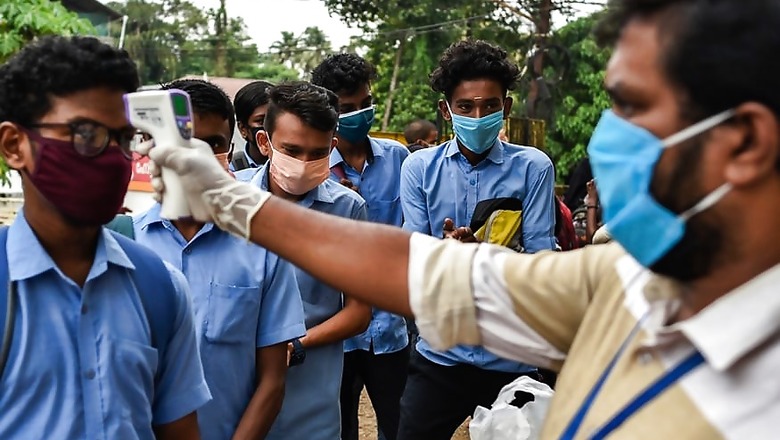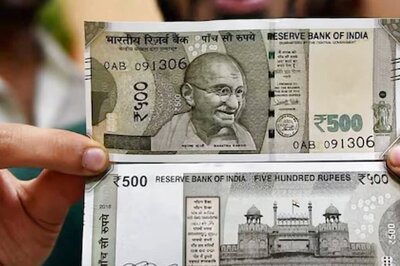
views
With a million cases and 4,000 deaths, the spotlight is back on Kerala, which was the first state to report the entry of Covid-19 into the country in January last year. The state with the finest social infrastructure and a health system that did not flinch even when the pandemic raged across the country in May 2020, is now fighting a new challenge all over again. Health analysts, though, are somewhat relieved. This “second wave”, if it indeed were so, is in one state that can handle any crisis better than any other in the country. The fatality rate in Kerala is the lowest and the recovery rate is far higher than anywhere else in the country. However, does this mean we need to do more? Like focus all our vaccinations efforts in Kerala first, and give the state everything it needs?
Kerala has always been under attack, interestingly on account of its runaway successes in the fields of education and healthcare. The benchmark for this outlier state is usually some Scandinavian country, not the rest of India. The average Keralite lives at least 5 years more than any other Indian. Four times more infants die in the rest of the country per 1,000 live births, while Kerala boasts of an IMR of 7 per 1,000. And while nearly 200 women per lakh pregnancies die in Uttar Pradesh, the Maternal Mortality Rate in Kerala is at 42 women. As a result, Kerala has the largest cohort of aged people. 12 per cent of the population is above 60 and 15 per cent of them are above 80 years old. The all-India average of 60 plus people is far lower at 8.6. The old and the vulnerable need to be vaccinated first; that’s the surest way of saving them in case they get infected.
This in many ways explains why Kerala today is topping the list of new cases. Covid-19 has been a predominantly urban phenomenon, particularly affecting those above 60. Kerala is one continuous stretch of urban and peri-urban settlements and is the third most densely populated state in the country. It also has the best performing health information systems, and has been testing, tracking, and tracing the pandemic for the last 12 months with remarkable accuracy. It logically follows therefore that the asymptomatic disease prevalence in the state is so low. Kerala again is the only state where the sero survey results are out and show that only a tenth of the population has been exposed to the virus. Delhi meanwhile is at 56%. The elusive herd immunity will not happen in Kerala in a hurry; vaccinations must be accelerated urgently.
The problems that Kerala faces are many and on various fronts. Its health ecosystem provokes envy among all other states that have simply collapsed under the burden of the pandemic. Delhi, Mumbai and Bengaluru have all struggled with scarcity of hospital beds, ICUs and ventilators. Reports of patients dying while running from hospital to hospital getting admission declined were rampant during the lockdown. The sole exception was Kerala despite its large numbers. The state also got inundated with its emigrant labour returning home, from all parts of India and indeed the world. The pressure on the system was huge and kept going up.
The first point on Covid-19 and vaccinations is about the data. Kerala has been the only state that has regularly been putting up the testing and tracking data on its website. The Kerala government’s Covid dashboard is brutally transparent and gets updated in real time. Therefore, the numbers are rarely contested, unlike in other parts of the country where they often appear fudged, the deaths undercounted and the recoveries overstated. Kerala at the top of the list of daily cases could very well be a result of this transparency and robustness of data. It is this data that would enable the state machinery to monitor the vaccine flow chart, the most vulnerable first. Then use the tracking mechanism to ensure the second dose is given to all, on time. Other states are reporting a huge drop in attendance among those scheduled for their second vaccine.
Secondly, the concentration of the disease in Ernakulam and Kozhikode, the top two cities by way of new cases, shows a certain degree of laxity among an otherwise prevention-conscious citizenry. The festival season and the opening of entertainment zones has clearly lowered the level of caution and emboldened people to take their masks off and ignore distancing norms. The health minister has appealed and warned all people about the new 6,000 plus daily infections since mid-January. Once the guard is down, it is often difficult to put it up again. Also, while the communication needs to get stronger, vaccines must be rushed in
Thirdly, and most importantly, is the vaccine excitement that is evident everywhere in the state. The inoculations have started, and everyone expects the vaccines to be delivered and administered quickly. However, the pace of vaccination is still very slow, across the country and the Government of India has still not indicated a clear roadmap. Till then the need for continuous tracking of superspreaders must go on. With bars, stadiums and cinema halls filling up, this will be difficult but cannot be relaxed. The early success with containment must be repeated, if the new wave is to be quelled.
The local population is riddled with comorbidities. The proportion of people suffering from obesity, hypertension and diabetes is possibly the highest in the country, according to the most recent National Family Health Survey. Comorbidity has been the single biggest cause of death among those who tested positive. Kerala’s relatively low crude death rate stands testimony to the strength of the health system, that is heralded the world over and rightly so.
The conclusion therefore is clear. Kerala must continue its yearlong meticulous collection of data. Tracking and tracing those in contact with positive patients must be followed up with quarantine and regular checks. The need to remind people about continuing to wear masks and maintain distancing is also very critical. What flows quite naturally from the discussion so far, is the need to launch a massive vaccination drive. Kerala has the wherewithal to store, distribute and administer the vaccine, better than any other state. The agonisingly slow pace of vaccination that we see across the country must pick up urgently.
It is simply inexplicable and frustrating to see that India’s goal of mass vaccination by August 2021, in itself a rather lazy target, will not be met. The union government must inject some dynamism, procure enough doses and supply them to Kerala where the population satisfies all the conditions for prioritising them. The plus-50 age group is substantial, comorbidities are rampant, urban population is large, active caseload is the highest, and, most importantly, the health system can administer the vaccines almost immediately.
(Disclaimer: The Author is Professor of Economic Policy at MCRHRDI. Views Expressed are Personal.)
Read all the Latest News, Breaking News and Coronavirus News here




















Comments
0 comment